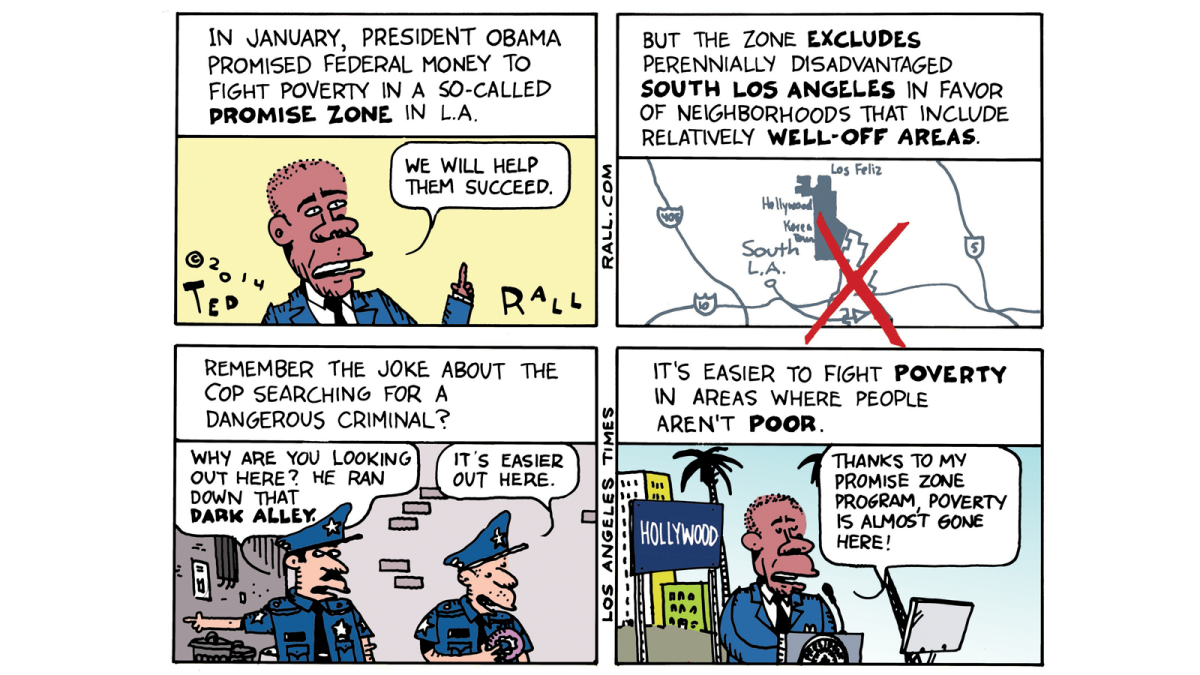Opinion: Anti-poverty Promise Zone neglects some of L.A.’s poorest. Thanks Obama.

The United States of America in Year 2014 is the wealthiest nation that has ever existed. Poverty among Americans is an obscenity: immoral, unnecessary, counterproductive. As disgusting as it is to watch $100,000 cars zoom past homeless panhandlers, however, there’s something even worse: politicians who pretend to care, who say they’re trying to help the poor and the downtrodden, but are actually ignoring them as they revel in the institutional corruption of politics-as-usual.
As The Times’ Michael Finnegan, David Zahniser and Doug Smith reported:
“In January, President Obama announced a block-by-block approach to relieving poverty in Los Angeles. Federal money, he said, would pour into a newly created Promise Zone.
“The boundaries encompassed crowded immigrant communities around MacArthur Park and Koreatown, as well as upscale areas of Hollywood and Los Feliz. Left out was South L.A., where the poverty rate is higher. The exclusion stunned many South L.A. leaders.”
Why did the White House snub South L.A., which is quantifiably poorer?
“Only those previously funded organizations were eligible to seek Promise Zone aid. In Los Angeles, there was only one such group: a nonprofit led by Dixon Slingerland, a major campaign fundraiser for Obama and frequent White House visitor.
“Under rules set by the White House and federal agencies, Mayor Eric Garcetti’s office, working with Slingerland’s Youth Policy Institute, was required to draw the zone’s boundaries around an area where the nonprofit already was focusing its federal grants — either Hollywood or the northeast San Fernando Valley.
“The result was an anti-poverty zone that left out communities south of the 10 Freeway, including areas of chronic poverty that drew worldwide attention after the 1965 and 1992 riots. Neighborhoods around Watts have a poverty rate 21% higher than communities within the Promise Zone, according to a Times analysis of U.S. Census Bureau data. Neighborhoods east of USC have a poverty rate 39% higher.”
This appears to be a political manifestation of the phenomenon described in the important 1996 book “The Winner-Take-All Society.” Influence begets influence, wealth and power aggregate into increasingly fewer hands. It’s why, for example, the best-paid professional athletes get the biggest offers for lucrative product endorsement deals. The more famous you are, the more stuff you can sell. The more stuff you sell, the more famous you get.
“It just seems like those that have keep getting,” said Rep. Janice Hahn, who represents parts of South L.A., after the news broke that South L.A. had been excluded. “And those that never had don’t even have a chance.” Hahn “pointedly skipped” a White House ceremony where Obama announced L.A.’s Promise Zone.
City Councilman Bernard C. Parks, who represents part of South L.A., pointed to Slingerland’s influence with the president: “You know exactly why they came out first. It was preordained.”
Slingerland denies that the Promise Zone’s odd mapping had anything to do with political payback.
Perhaps not. But if Slingerland wanted favors from Obama, he was certainly in a position to ask. Finnegan et al noted: “Since Obama took office, Slingerland has been to the White House 19 times, logs show. The visits included one to the residence for a reception, three to the West Wing and 10 to the Old Executive Office Building. He attended two receptions at Vice President Joe Biden’s home at the U.S. Naval Observatory.”
I don’t know about you, but I’m still waiting for my first invite.
The soft corruption of coziness, or coincidence? I know not. But it definitely looks bad.
And it doesn’t just look bad in Los Angeles. The other four PZs are drawing fire too.
According to the Philadelphia Inquirer, “several areas of the city face challenges similar to or worse than Mantua’s,” the West Philly neighborhood designated as that city’s Promise Zone.
Politics appears to have influenced the selection of at least three of the first five Promise Zones. “Rural Kentucky, of all the distressed rural districts and deserving areas across the country, seems a somewhat random choice, but Kentucky Sens. Rand Paul and Mitch McConnell both attended the [Promise Zone] announcement, perhaps boosting the chances of bipartisan support,” wrote Susan Greenbaum.
But hey, maybe residents of South L.A. should be relieved that the Obama administration gave them the cold shoulder. If the Promise Zones work as advertised, planning experts say, they’ll spur gentrification, rising rents and — ultimately — evictions.
And as always, the rich get richer and the poor get ignored.
ALSO:
Photo gallery: Ted Rall cartoons
Rolling Stone learns the naked truth about fact-checking
Handsome Rob Lowe says good-looking people have it tough. Please.
Ted Rall, who draws a weekly editorial cartoon cartoonist for The Times, is also a nationally syndicated opinion columnist and author. His new book is “Silk Road to Ruin: Why Central Asia is the New Middle East.” Follow Ted Rall on Twitter @TedRall.
More to Read
A cure for the common opinion
Get thought-provoking perspectives with our weekly newsletter.
You may occasionally receive promotional content from the Los Angeles Times.





